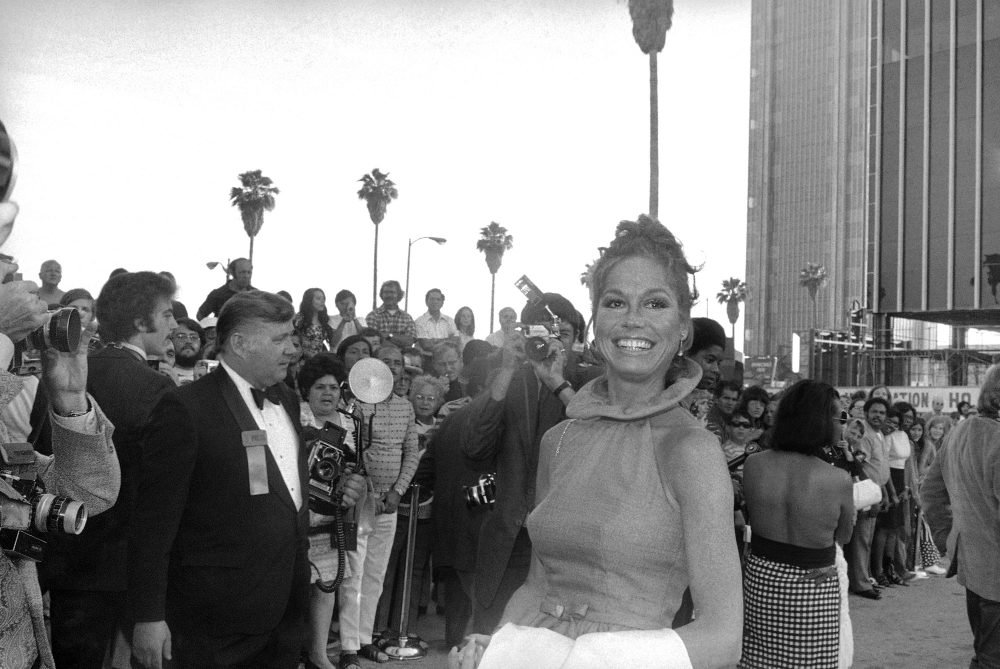Advertisement
Hats Off: Remembering Mary Tyler Moore

COMMENTARY
When I was growing up in the 1960s, there were only two television women who mattered: Lucille Ball and Mary Tyler Moore.
On her half-hour sitcom with television and real-life husband Desi Arnaz, Ball wore frumpy dresses. On her show with fictional spouse and real-life friend, Dick Van Dyke, Moore (playing Laura Petrie) wore sleek capris and flats and tailored shirts. Ball behaved like a child; Moore tolerated the childish behavior of others. Ball stomped, and Moore danced. Ball wailed, while Moore, wedded as much to her dignity as to her husband, fought back frustrated tears.
[Laura Petrie's disappointed pitch on The Dick Van Dyke show] was the sound of an entire generation of housebound, middle-class suburban white women who were comfortable, languishing and bored out of their minds.
"Ooooohhhh, Robbbbbb," Moore as Laura would protest in the face of some silliness or disappointment. Her pitch low but rising, the two syllables stretched into twelve, her voice was the sound of pressured steam being released through a tiny valve. It was the sound of an entire generation of housebound, middle-class suburban white women who were comfortable, languishing and bored out of their minds.
I loved Lucy, but I wanted to be Mary.
Or, at least, aspects of her, both as married, formerly employed, New Rochelle-dwelling Laura Petrie, and as Mary Richards, the single, city-living, self-supporting assistant producer of a television news show. In both The Dick Van Dyke Show and The Mary Tyler Moore Show — and the whole story is epitomized just in that progression of titles — Moore was proud, feisty, loving but not simpering, and subtly but insanely funny.
Media historians have talked about how The Mary Tyler Moore Show, which debuted in 1970, marked a turning point in American popular culture. At last we had a hero who was a heroine; a single, sexually active woman whose friends served as family; a workplace comedy in which men and women could be friends, not exclusively lovers, and could engage in ever-more open struggle for the right to be boss.
That’s all true, and I imagine that at age 16, I welcomed and absorbed much of Mary Richard’s fictitious life as a vision of what my own could be. But at that age, I was also observant enough to notice the paucity of protests and people of color on the show, and of course judgmental enough scorn most of the men that Mary dated, and the ludicrous painted gold M that she had hanging on her wall.
Besides, Mary was a very, very white Presbyterian. Just as my favorite character on The Dick Van Dyke Show was the tough, wisecracking comedy writer, Sally Rogers, on her next show it was Mary’s Jewish, New York City-accented friend Rhoda, to whom I related most.
“Rhoda, do you think I’m undersexed?” Mary demands of her friend on one episode. “I hope so,” Rhoda answers. “I’d like to think there’s one thing I’m better at than you are.”
Still, despite this litany of objections – both at the time and retrospectively – I adored that show. And now, revisiting the famous “Chuckles the Clown Bites the Dust” episode through my older woman’s eyes, I think I better understand why.
One of the local channel’s stars, Chuckles the Clown, has died in a bizarre accident, and before his funeral, Mary is scandalized by jokes her wisecracking colleague Murray makes about the clown’s ridiculous demise. But as the funeral progresses, as the minister recounts Chuckle’s legacy, she finds herself seized by increasingly uncontrollable laughter.
Mary Tyler Moore’s hilarity bursting out from between pursed lips, her mortification and attempts to deflect attention, her hunched body and incredulous eyes, her desperate and futile efforts to behave appropriately, represent some of the best comedic acting I’ve ever seen.
Beyond her jubilant hat throw, beyond her financial independence and contented singleness, [Mary Tyler Moore as Mary Richards] literally embodied the tension women felt between what was “appropriate” and what was authentic.
Looking back at other episodes over the course of years, I realize just how Moore excelled at depicting that struggle for control, over herself and over her circumstances.
And that’s how Mary Richards and the brilliant actor who played her awakened us in those years. Beyond her jubilant hat throw, beyond her financial independence and contented singleness, she literally embodied the tension women felt between what was “appropriate” and what was authentic. In so doing, she helped to create a new, better normal.
That new normal may now look like a quaint past, but now, given all that we as a nation are facing, it’s looking better than ever. So thank you, Mary. Hat's off.

